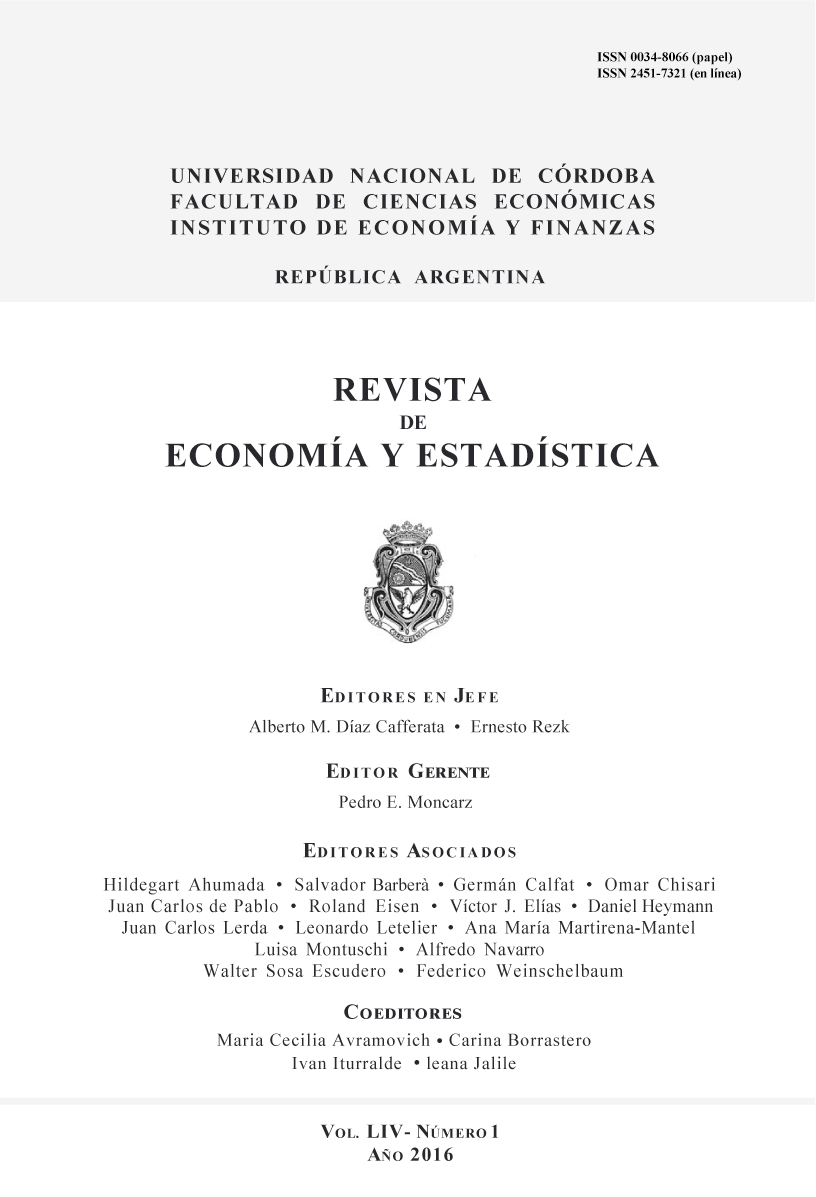Estándares laborales mínimos, comercio bilateral y multilateral
DOI:
https://doi.org/10.55444/2451.7321.2016.v54.n1.20291Palabras clave:
exportaciones, comercio internacional, normas laborales, OIT, modelos de gravedadResumen
Los estándares laborales mínimos definidos por la OIT en 1998 son universales pero se aplican de manera muy diferente en los distintos países. El cumplimiento es mucho más alto en los países de altos ingresos. Sin embargo, la causalidad entre la mejora de las normas laborales y el crecimiento económico sigue siendo un tema controvertido. Las estrategias de crecimiento dirigidas por las exportaciones pueden alentar a los países en desarrollo a frenar el proceso de mejora de las normas. De esta forma, pueden aumentar el volumen de sus dotaciones de mano de obra no calificada (trabajo infantil y / o forzado) a fin de fortalecer su ventaja comparativa sobre los países que cumplen con los requisitos. Utilizamos un modelo de gravedad para evaluar el impacto comercial del nivel de cumplimiento de las normas laborales fundamentales, distinguiendo los efectos sobre el comercio bilateral (especialización geográfica) de los efectos multilaterales. Mostramos que los países que cumplen con las normas laborales tienden a comerciar más entre sí, mientras que los países que no cumplen tienden a comerciar más con los países que cumplen con los requisitos. Estos efectos se identifican principalmente con respecto al trabajo infantil y la libertad de asociación. Los países que cumplen con los estándares laborales tienden a ser menos abiertos, pero de manera diferente dependiendo de los estándares, con una relación no lineal para algunos de ellos. Los países menos dóciles pueden al mismo tiempo intensificar sus normas comerciales y laborales. Para los países medianos, principalmente los países emergentes, el nivel de cumplimiento de las normas laborales es "óptimo".
Descargas
Citas
Agustí-Panareda, J., Ebert, F.C. and LeClercq, D. (2014). “Labour Provisions in Free Trade Agreements: Fostering their Consistency with the ILO Standards System”, ILO, March.
Aidt, T., Tzannatos, Z. (2002). “Unions and collective bargaining: economic effects in a global environment”. Directions in Development Series, The World Bank, Washington D.C.
Anderson, J.E., van Wincoop, E. (2003). “Gravity with Gravitas: A Solution to the Border Puzzle”. The American Economic Review, 93, 170-192.
Arestoff, F., Granger, C. (2003). “Le respect des normes de travail fondamentales: une analyse économétrique de ses déterminants ”. Cahiers de recherche EURISCO, 2003-08, Université Paris Dauphine.
Bagwell, K., Staiger, R.W. (1998). “The Simple Economics of Labor Standards and the GATT”. NBER Working Paper Series, No. 6604.
Baldwin R., Taglioni D. (2006). “Gravity for Dummies and Dummies for Gravity Equations”. NBER Working Paper, No. 12516, September.
Basu, K. (1999). “Child Labor: Cause, Consequence, and Cure, with Remarks on International Labor Standards”. Journal of Economic Literature, 37(3), 1083-1119.
Basu, K. (2000). “The Intriguing Relation between the Adult Minimum Wage and Child Labour”. The Economic Journal, 110 (1), 50-61.
Basu, K., Van P.H. (1998). “The Economics of Child Labor”. The American Economic Review, 88(3), 412-427.
Bazillier, R. (2008). “Core Labour Standards and Economic Development: impact on long term per-capita income”. World Development, 36(1), 17-39.
Becker, G. S. (1971). The Economics of Discrimination. The University of Chicago Press, Chicago.
Bonnal, M. (2010a). “Economic Growth and Labor Standards: Evidence from a Dynamic Panel Data Model”. Review of Development Economics, 14(1), 20-33.
Bonnal M. (2010b).“Export Performance, Labor Standards and Institutions: Evidence from a Dynamic Panel Data Model”. Journal of Labor Research, 31(1), 53-66.
Brown, D.K., Deardorff A.V., Stern R.M. (1996). “International Labor Standards and Trade: A Theoretical Analysis”. In J. N. Bhagwati and R. E. Hudec (eds), Harmonization and Fair Trade: Prerequisites for Free Trade? Cambridge, US: Cambridge MIT Press.
Brown, D.K., Deardorff A. V., Stern R. M. (2011). “Labor Standards and Human Rights: Implications for International Trade and Investment”. IPC Working Paper Series No. 119, University of Michigan.
Busse, M. (2002). “Do Labor Standards Affect Comparative Advantage in Developing Countries?”. World Development, 30(11), 1921-32.
Busse, M. (2003). “Do transnational corporations care about labor standards?”. The Journal of Developing Areas, 36(2), 39-56.
Busse, M. (2004). “On the determinants of core labour standards: the case of developing countries”. Economics Letters, 83(2), 211–217.
Busse, M., Braun S. (2003). “Trade and investment effects of forced labour; an empirical assessment”. International Labour Review, 142(1), 49-71.
Casella, A. (1996). “On Standards and Trade: a Review of Simple Results”, in Bhagwati and Hudec (eds.), Fair Trade and Harmonization: Prerequisites for Free Trade?, MA: MIT Press, Cambridge.
Chau, N.H., Kanbur R. (2001). “The Adoption of Labour Standards Conventions: Who, When and Why?”. C.E.P.R. Discussion Papers, No. 2904.
Cooke, W., Noble D. (1998). “Industrial Relation Systems and US Foreign Direct Investment Abroad”. British Journal of Industrial Relations, 36(4), 581-509.
Dehejia, V.H and Samy, Y. (2004). “Trade and Labour Standards: Theory and New Empirical Evidence”. Journal of International Trade and Economic Development, 13(2), 179-198.
Dinopoulos, E., Zhao, L. (2007). “Child Labor and Globalization”. Journal of Labor Economics, 5(3), 553-79.
EC-ILO (2011). Trade and Employment: From Myths to Facts. ILO-EC publication, International Labour Office, Geneva.
Edmonds, E., Pavnicks, N. (2002). “Does Globalization Increase Child Labour? Evidence from Vietnam”, NBER, Working Paper Series, No. 8760.
Edmonds, E., Pavnicks, N. (2006). “International Trade and Child Labor: Cross-Country Evidence”. Journal of International Economics, 68(1), 115-140.
Eliott, K.A. (2003). “Labor Standards and the Free Trade Area of the Americas”. Institute for International Economics, WP 03-7. Available at http://www.iie.com/publications/wp/03-7.pdf
Feenstra, R.C., (2004). Advanced International Trade. Theory and Evidence. Princeton, Princeton University Press.
Galli, R., Kucera D. (2004). “Labor Standards and Informal Employment in Latin America”. World Development, 32(5), 809-828.
Granger, C. and Siroën, J.-M. (2009). “Cases to include labour standards in WTO” in J.-ren Chen, Ch. Smekal and K. Socher eds. Contributions to the Studies of International Institutions to Global Governance, Innsbruck University Press.
Granger, C. (2003). “Normes de travail fondamentales et commerce international”. PhD Dissertation, Université Paris-Dauphine, December 2003.
Granger, C. (2005). “Normes de travail fondamentales et échanges sud-nord”. Economie internationale, 101 (1), 47-62.
Granger, C., Siroën J.-M. (2006). “Core Labor Standards in Trade Agreements. From multilateralism to bilateralism”. Journal of World Trade, 40:5, 813-836.
Griswold, D. (2001). “Trade, Labor and Environment: how blue and green sanctions threaten higher standards”. Trade Policy Analysis, 15, CATO Institute, August.
Hansson, G. (1981). “Social Clauses and International Trade: An Economic Analysis of Labour standards and Trade Policy”. Lund Economic Studies.
International Labour Office (2002). Every Child Counts. New Global Estimates on Child Labour, Geneva, Switzerland.
International Labour Office (2013). The Social Dimensions of Free Trade Agreements, Geneva, Switzerland.
Kamata, I (2014). “Regional Trade Agreements with Labor Clauses: Effects on Labor Standards and Trade”. Kyoto University, Graduate School of Economics, Discussion Paper No. E-13-007.
Kucera, D. (2002). “Core Labour Standards and Foreign Direct Investment”. International Labour Review, 141(1-2), 31-69.
Kucera, D. and Sarna, R. (2006). “Trade Union Rights, Democracy, and Exports: a Gravity Model Approach”. Review of International Economics, 14(5), 859-882.
Limão, N. (2005). “Trade Policy, Cross-border Externalities and Lobbies: Do Linked Agreements Enforce More Cooperative Outcomes?”. Journal of International Economics, 67(1), 175-199.
Lucas, R.E. (1988). “On the mechanics of economic development”. Journal of Monetary Economics, No. 22, 3-42.
Mah, J. (1997). “Core Labor Standards and Export Performance in Developing Countries”. World Economy, 20(6), 773-785.
Martin, W., Maskus, K.E. (2001). “Core Labour Standards and Competitiveness: Implications for global trade policy”. Review of International Economics, 9(2), 317–28.
Maskus, K.E. (1997). “Should Core Labor Standards Be Imposed Through International Trade Policy?”. Policy Research Working Paper, WPS 1817, Washington DC, US: The World Bank.
Morici, P., Shulz E. (2001). Labor Standards in the Global Trading System, Washington DC, US: Economic Strategy Institute.
Neumayer, E. and de Soya I. (2005). “Trade Openness, Foreign Direct Investment and Child Labor”. World Development, 33(1), 43-63.
OECD (1996). “Trade, Employment and Labour Standards: A Study of Core Workers' Rights and International Trade”, Paris, OECD.
OECD (2000). “International Trade and Core Labour Standards”, Paris, OECD.
OECD (2007). “Export processing zones: past and future role in trade and development”. OECD Trade Policy Working Paper No. 53.
Raynauld, A., Vidal, J.P. (1998). Labour Standards and International Competitiveness: A Comparative Analysis of Developing and Industrialized Countries. Cheltenham: Edward Elgar.
Rodrik, D.. (1998). “Globalisation and Labor, or if Globalization is a bowl of cherries why are there so many glum faces around the table?”. In D. Cohen et al. (eds), Market Integration, Regionalism and the Global Economy, Cambridge, UK: Cambridge University Press.
Romer, P.M (1989). “Human capital and growth: theory and evidence”. Journal of Political Economy, No. 98.
Santos Silva, J.M.C., Tenreyro S. (2006). “The Log of Gravity”. The Review of Economics and Statistics, November, 88(4), 641-658.
Santos Silva, J.M.C., Tenreyro S. (2011). “Further simulation evidence on the performance of the Poisson pseudo-maximum likelihood estimator”, Economics Letters, August, 112(2), 220-222.
Shelburne, R.C. (2004). “Wage Differentials, Monopsony Labor Markets, and the Trade-Labor Debate”. Journal of Economic Integration, 19(1), 131-161.
Siroën, J.-M. (2013). “Labour provisions in preferential trade agreements: Current practice and outlook”. International Labour Review, 152(1), 85–106.
Solow, R. M. (1956). “A contribution to the theory of economic growth”. Quarterly Journal of Economics, 70, 65-94.
Thomas, C. (2002). “Trade-Related Labor and Environment Agreements?”. Journal of International Economic Law, 5(4), 791-819.
Van Beers, C. (1998). “Labour Standards and Trade Flows of OECD Countries”. The World Economy, 21(1), 57-73.
Winkelmann, R., (2003). Econometric Analysis of Count Data, 4th ed. Berlin: Springer-Verlag.
Descargas
Publicado
Cómo citar
Número
Sección
Licencia

Esta obra está bajo una licencia internacional Creative Commons Atribución-NoComercial-SinDerivadas 4.0.
Aquellos autores/as que tengan publicaciones con esta revista, aceptan los términos siguientes:
Los autores/as conservarán sus derechos de autor y garantizarán a la revista el derecho de primera publicación de su obra, el cuál estará simultáneamente sujeto a la Licencia Creative Commons Atribución-NoComercial-SinDerivar 4.0 Internacional que permite a terceros compartir la obra siempre que se indique su autor y su primera publicación esta revista.
Los autores/as podrán adoptar otros acuerdos de licencia no exclusiva de distribución de la versión de la obra publicada (p. ej.: depositarla en un archivo telemático institucional o publicarla en un volumen monográfico) siempre que se indique la publicación inicial en esta revista.
Se permite y recomienda a los autores/as difundir su obra a través de Internet (p. ej.: en archivos telemáticos institucionales o en su página web) antes y durante el proceso de envío, lo cual puede producir intercambios interesantes y aumentar las citas de la obra publicada. (Véase El efecto del acceso abierto)









